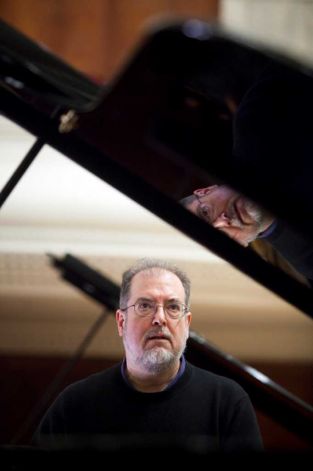Ohlsson recital shows a gentler side with Chopin, Scriabin
Although it’s unlikely that the ULTRA rave-fest siphoned off any patrons, the attendance was sparse for Garrick Ohlsson’ third appearance with the New World Symphony in as many days. In contrast with the massive Rachmaninoff Concerto No. 2 Ohlsson played Friday and Saturday, Sunday’s program featured intimate piano solos and one chamber piece.
Consistently clean, gentle restraint characterized Ohlsson’s performances. Although capable of fire, Ohlsson largely eschewed aggression for sonic purity and quiet understatement.
In Beethoven’s Sonata No. 30 in E-flat, Op. 109, Ohlsson’s tenderness and bell-like melodies melted any dissonances into comforting themes, capturing its Classical essence. His contrasting strength in the Prestissimo was still subordinated to melody, with well-defined low register lines and liberal rubato.
Ohlsson’s Andante chorale opening was much too gentle, losing definition at the ends of several phrases. However, his impressive variations ventured into Romantic territory with precise staccato, lushly alternating chords, and flashy marcato. After a bright contrapuntal variation, soft tremolos graced Ohlsson’s reprise of the delicate theme.
For Mozart’s Wind Quintet in E-flat major, K. 452, Ohlsson stepped back into a supportive role for oboist Kevin Pearl, clarinetist Brad Whitfield, horn player Alexander Love and bassoonist Evan Epifanio.
Blending winds’ distinctive timbres is always a challenge, but the ensemble’s unified phrasing illuminated Mozart’s graceful figures in the Largo-allegro moderato. In the Larghetto, layered trills, counterpoint, and stately wind chords conveyed an air of refinement. Brightness, sinuous lines and silky blending marked the final Rondo allegretto, with ever-changing combinations of instrumental color adding interest.
Ohlsson’s scheduled Scriabin’s Sonata No. 3 wasn’t played Sunday, but no one was disappointed when he offered his specialty instead: two works by Frederic Chopin.
The Fantasy in F minor, Op. 49 possessed the same clarity as the Beethoven, plus subtle colors via expert pedaling. Ohlsson expanded organically from quiet to turbulence, transforming coy upper-register passages and jaunty marches over time into more substantial ideas. Exquisitely delicate passages and a soft chorale enhanced Ohlsson’s final full-speed burst.
Chopin’s Nocturne in D-flat op. 27 No. 2 was not the most challenging work, but seemed the best fit for Ohlsson’s reserved style. Lightly cascading chords and a pastoral air tinged with chromaticism provided a backdrop for effortless, astonishing ornamentation, proof of Ohlsson’s special expertise in this composer.
Unlike No. 3, Ohlsson has kept Scriabin’s Sonata No. 5, Op. 53 in his repertoire for 30 years. His experience showed in his stormy opening, dissolving quickly into an impressionistic texture. Hammer blows of the motive, stretched tempos and shimmering accompaniments made for a dramatic reading. Ohlsson’s clear motives remained traceable throughout ferocious, whirling variations. In a thunderous ending, Ohlsson unexpectedly leapt off the bench, a la Victor Borge.
By popular demand, Ohlsson performed two encores. Scriabin’s youthful Etude in C sharp minor Op. 2, No. 1 featured a searching, pearly melody and rising dark chords. Scriabin’s Etude in G sharp minor Op. 8, No. 12 was a perfect foil, with Ohlsson channeling the height of Romantic passion in fierce octave runs, a powerful ending to a generous program.
Posted in Performances
Leave a Comment
Mon Mar 31, 2014
at 11:45 am
No Comments







